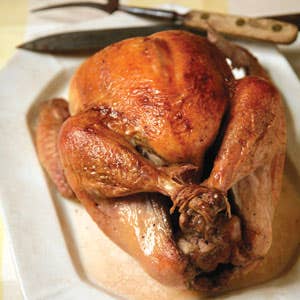
A Guide to Buying Turkey
CONVENTIONAL: This perennial favorite—typically a Broad-Breasted White variety—boasts an ultraplump breast that has usually (but not always) been injected with butter, water, and salt; it will be labeled "self-basted" if it contains these ingredients. Though the flesh tastes appealing when spruced up with gravy and cranberry sauce, it can be bland on its own. The price is the real selling point, as conventional turkeys are the least expensive, per pound.
NATURAL: Our favorite turkeys (often described as "minimally processed") are those that haven't been treated with artificial colors or flavor-enhancing ingredients. (Higher-priced "organic" turkeys are bred according to strict rules established by the USDA.) Like their conventional counterparts, natural turkeys are usually a Broad-Breasted White variety. Though you'll pay more than you would for a convention turkey, most have a clean, pure turkey flavor and moist flesh.
HERITAGE: This category of turkeys comprises a host of old-time varieties, like Narragansett and Bourbon Red, which were staples of the pre-World War II American turkey industry. These breeds mature slowly; thus, their flesh can be pleasantly flavorful and moist—or unpleasantly gamy and chewy. It's worth doing your research before buying: they're by far the most costly turkeys available.
Keep Reading
Continue to Next Story










